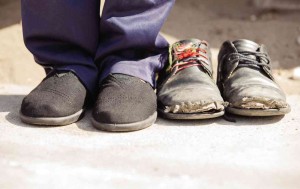
The idea of charitable consumption, especially in the fashion industry, has always perplexed many. Buying a pair of shoes to “give back” seems unnecessary, even ridiculous, when you can just give a pair of old flip-flops to a kid on the street.
Last December, a few days after Super Typhoon “Yolanda” hit the Visayas, a group of editors, designers, business owners and philanthropists joined hands to sell luxury bags, shoes and clothes to raise funds for the disaster victims.
There were raised eyebrows when people flocked to Forbes and Dasmariñas Village, where the sales were set up. Some went to truly assist in the fundraising, while others probably just wanted to make the best out of the rare designer discounts.
Toms, in a similar way, has been widely criticized by consumers, social entrepreneurs and organizations because of its Buy One Give One model—you buy a pair of shoes or sunglasses, and a person in need will receive the same.
However, Toms aims to provide support to a specific sector—children from first grade to fourth year high school who do not enjoy government aid.
Over the past eight years, Toms has given away over 10 million pairs of shoes (success, by the way, that has allowed it to expand into other products such as eyewear, clean water and coffee).
The company partners with humanitarian organizations to reach out to kids and provide them footwear that can protect them from infections and in the rough terrain, thus making it possible for them to attend school.
Toms’s shoe campaign has been done in places such as Ethiopia, Kenya, Argentina and China. The shoes it donates are sourced locally, which helps create jobs, support local artists and boost local suppliers.
Christopher Marquis, co-writer of the Stanford Social Innovation Review’s “Inside the Buy One Give One Model,” wrote in that book: “The One for One formula works best if it’s identity-oriented. A consumer is more likely to buy a product ‘that gives back’ if it tells something about the consumer as a person that makes them feel connected to the social mission of the company.”
That is why most companies like Toms with the One for One business model sell apparel: clothing, shoes, backpacks and baby clothes.
That is also the reason the garage sale for Yolanda victims raised almost P3 million in only three weeks. It was proof that people will shell out more, and fast, if they can readily display their loyalty to a cause.
It’s now called CSV—Creating Shared Value—which is a win-win approach involving not just the consumer and seller, but everyone with a stake in the proceedings: suppliers, middlemen, stockholders and communities.
This concept of shared value disputes giving away free stuff, and instead, encourages a system that will benefit the most parties to make it sustainable. Instead of asking for your P5,000 in cash, the garage sale opted to propose: You get a pair of Roger Vivier pumps if you give P5,000 in cash, and the proceeds will go to the victims of the typhoon.
With a system like this, it doesn’t matter if the consumer shopped for herself or for the victims; everyone gains from the sale.
There are all kinds of ways to help, and one does not need to shop to do so. But the idea of “fashion for a cause” says people do not necessarily have to change or disdain the system, they just have to make it work for the benefit of many—as Toms is doing.
Toms is available in Shoe Salon in Glorietta 3, SM Mall of Asia and Shangri-La Plaza Mall; Nothing But H20 in Alabang Town Center and Trinoma, Jump in Bonifacio High Street, Eastwood Mall and Greenbelt 5; Marquee Mall Angeles City; Rustan’s Cebu; Abreeza Mall Davao City.